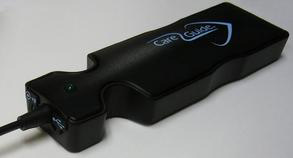Medical Care Goes Mobile
Every day for deployed troops around the world, hours, minutes, and even seconds can mean the difference between life and death on the battlefield. After over a decade of continuous conflict, hemorrhage control is holding strong as the most important life saving aspect in battlefield medicine today, with approximately 85% of "potentially survivable" deaths attributed to severe blood loss.
Great strides continue to be made in the area of combat casualty care, and the medical system is increasingly moving its resources closer to the front lines to be more responsive to patients' needs during those crucial moments following injury.
On April 18, ZOLL Medical Corporation made the public announcement that it was entering into an agreement with Reflectance Medical, Inc., in an initiative to develop and market a ruggedized version of the Mobile CareGuide 3100.
The Mobile CareGuide 3100 — a sensor that now allows medical personnel to obtain tissue measurements of oxygen and pH without a blood sample, and identify patients about to go into shock more quickly than ever before — was designed with the goal in mind of saving lives and reducing complications that can and do result from inadequate resuscitation.
Since 2009, the RMI team has been working toward the development of this next generation military sensor, with the original CareGuide 1100 receiving clearance from the U.S. Food and Drug Administration in July 2012 and the second-generation CareGuide 2100 following closely behind with clearance in December 2012. The latest version of the device, the Mobile CareGuide 3100 with SmO2 and pH, received its own FDA clearance most recently on July 19.
"The FDA clearance of the Mobile CareGuide 3100 with non-invasive pH measurement is a major milestone for the company," said Babs Soller, Chief Executive Officer at RMI.
"For the first time," continued Soller, "we can provide continuous, non-invasive, real-time assessment of patient acid-base status," — bringing ICU level monitoring capability to patients not only in the emergency room but outside of the hospital as well.
Initial development of the CareGuide concept did not come easy, and it certainly did not come without cost.
Groundwork for CareGuide concepts and systems was developed by Soller herself, with help from her post-doctoral research associates and staff, while she was as a professor of Anesthesiology at the University of Massachusetts Medical School. Soller then left UMass in late 2010, together with three members of her team, with the sole focus of developing the CareGuide product line.
"The U.S. Army Medical Research and Materiel Command and Combat Casualty Care Research Program funded the development of CareGuides 1100, 2100 and 3100," noted Soller.
RMI, located in Westborough, Mass., is made up of seven in-house employees, all working towards the common goal of bringing its CareGuide technology to market for both military and civilian critical care. Through strategic partnerships, RMI works with multiple outside partners who assist in CareGuide development, design and production.
One such partner is Dr. Victor Convertino, a senior scientist at the U.S. Army Institute of Surgical Research and manager of the Tactical Combat Casualty Care Research task area, funded by the CCCRP.
"For the past 8 years, our Human Physiology Laboratory investigators and I have conducted experiments in collaboration with Dr. Babs Soller using our human simulation of hemorrhage in an effort to study the response of tissue oxygen and pH during progressive hemorrhage," said Convertino.
The CCCRP, a critical research effort of the USAMRMC, works day-in and day-out toward the goal of saving the lives and reducing morbidity of troops injured in the line of duty through the development of lifesaving strategies, new surgical techniques, biological and mechanical products, and the timely use of advanced physiology monitoring.
"We have always worked closely with the CCCRP to make sure that our products meet the needs of the military in caring for casualties from the point-of-injury all the way through definitive care," said Soller.
According to the CCCRP website, approximately 20% of all combat deaths are considered "preventable" if timely, appropriate care had been available. Specifically, roughly 20% of all combat deaths considered to be "potentially survivable" occur prior to arriving at a combat support hospital, revealing this out-of-hospital, transport from point-of-injury timeframe to be the most significant opportunity for saving the lives of combat casualties. Combat medics must therefore have not only the concern of diagnosing and treating combat injuries as quickly as possible following injury, but they must also do so under not-so-conventional circumstances during transport.
Together with ZOLL, Soller and her team at RMI are moving forward toward making the jobs of combat medics a little easier.
"Our development efforts kicked off earlier this year, by jointly developing the specifications for the Mobile CareGuide 4100, a modification of the 3100 designed to meet military specifications and be certified for use on military aircraft," said Soller.
The Mobile CareGuide 4100 — a modification of the 3100 specifically for integration with ZOLL's monitor and defibrillator technologies — will have more ruggedized packaging for the optical sensor and a new disposable to attach the sensor to the patient. Additional software modifications will make it quicker and easier to get measurements started on injured patients.
"This effort is being funded by ZOLL, but as always, we incorporate the needs of the military into our specification through on-going discussions with USAMRMC and the CCCRP," added Soller. "Long term, we plan to work with our commercial partners to make Mobile CareGuide technology the standard of care for continuous assessment of trauma patient metabolic status both inside and outside the hospital," said Soller.
Initial designs for the Mobile CareGuide 4100 are finished, with the first working prototypes expected to be ready this fall.















